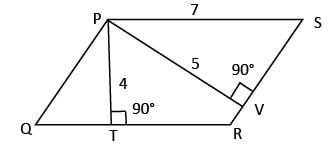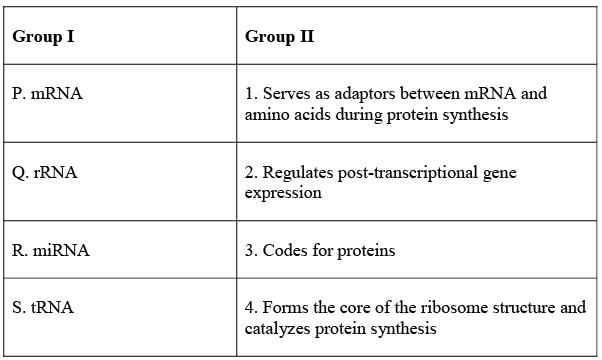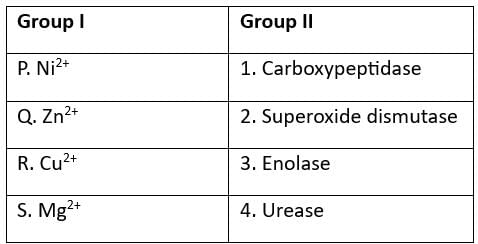GATE Biotechnology Mock Test - 1 - GATE Biotechnology MCQ
30 Questions MCQ Test - GATE Biotechnology Mock Test - 1
Which of the following words has an opposite meaning to the term PROFESSIONAL?
In the sentence below, a segment is incomplete. Four different ways to complete this sentence are presented. The best option among these four is
The interest sparked by the soccer World Cup is __________ in comparison to how cricket ________ the nation.
References : ______ : : Guidelines : Execute
(By definition)
(By definition)
In the figure provided, PQRS is a parallelogram where PS measures 7 cm, PT is 4 cm, and PV equals 5 cm. Determine the length of RS in centimeters. (The diagram is representative.)

Human beings are one of the many beings that exist in a conceptual realm. Within this conceptual realm, some beings exhibit cruelty. If it is established that the assertion “Some human beings are not cruel creatures” is FALSE, which of the following statements can be logically concluded with certainty?
(i) All human beings are cruel creatures.
(ii) Some human beings are cruel creatures.
(iii) Some creatures that are cruel are human beings.
(iv) No human beings are cruel creatures.
Deepika offers her products at a price that is 10% lower than Nidhi's prices and 10% higher than Gurpreet's prices. If a customer buys items from Nidhi for Rs. 100, how much would he have saved if he had purchased the same items from Gurpreet?
Which of the following statements accurately describes leghemoglobin?
Which of the following is essential for the maturation of B-cells within the bone marrow?
The eigenvalues associated with a skew-symmetric matrix are
Which enzyme is inhibited by iodoacetate, thereby disrupting the glycolytic pathway?
The method of introducing specific bacteria to an area for the purpose of degrading pollutants is referred to as
The vector that exhibits the greatest capacity for cloning is
Which of the following methods is employed for the global alignment of two protein sequences?
Assess the validity of the following Assertion [a] and the Reason [r].
Assertion [a]: Mutations in chromosomes can alter the structure of chromosomes.
Reason [r]: All mutations in chromosomes occur due to nondisjunction during mitosis or meiosis.
Identify the various types of RNA listed in Group I and match them with their respective functions described in Group II.

Fabry disease in humans is an X-linked condition. What is the probability (expressed as a percentage) that a phenotypically normal father and a mother who is a carrier will have a son affected by Fabry disease?
A batch consists of 10% defective items. From this batch, ten items are selected at random. What is the probability that exactly 2 of the selected items are defective? (Provide your answer rounded to two decimal places)
What is the distance between the two points where the equations x 2 + y = 7 and x + y = 7 intersect, rounded to two decimal places?
The point where the function sin x 2 + cos x achieves its maximum value over the interval [0, x] is
Identify the total number of bonds that can be hydrolyzed by trypsin and chymotrypsin in the subsequent oligopeptide sequence:
Tyr-Gly-Gly-Phe-Met-Lys-Lys-Tyr
Associate the cofactors in Group I with their corresponding enzymes in Group II.

A culture of bacteria has grown to 32 × 106 cells after 2.5 hours of exponential growth. If the bacteria have a doubling time of 30 minutes, what was the initial count of bacteria?
Which of the following statement(s) regarding induced pluripotent stem cells is(are) TRUE?
The methylation of CpG islands located near a gene's promoter can prevent transcription by
The event(s) responsible for the inactivation of tumor suppressor genes in cancer cells is(are)
What is the value of the rate constant kd for this process?
(Provide your answer rounded to 3 decimal places.)
What is the net charge of proline at a pH of 11.0, given that its isoelectric point (pI) is 6.3?
In a demographic investigation, a random selection of 1000 individuals was made, and their genotypes for a specific trait were analyzed. The distribution of genotypes was observed as follows:
AA = 800
Aa = 185
aa = 15
Calculate the frequency of the allele "a" within this population.
(Provide your answer rounded to 3 decimal places.)
Aqueous two-phase extraction is employed to isolate α-amylase from a solution. A mixture of polypropylene glycol and dextran is introduced, causing the solution to segregate into upper and lower phases. The partition coefficient is 4.0, and the volume ratio of the upper phase to the lower phase is 5.0. The yield or recovery of the enzyme (expressed as a percentage and rounded to the nearest integer) is ___________.















